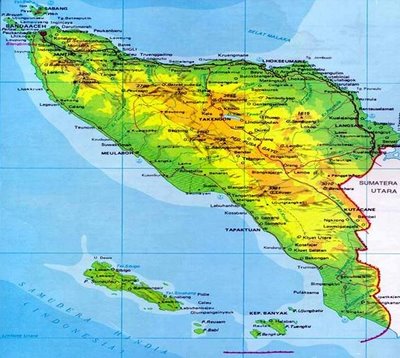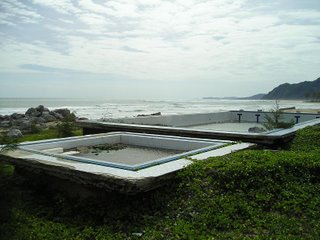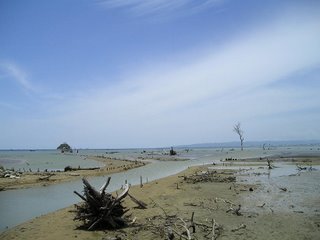June 23rd - One and a half year after the Tsunami
I have spent this week sorting out all the necessary administrative issues and started to immerse myself in the IRC programme. To familiarise myself with the Integrated Community Programs (ICPs) and gain a proper understanding of the context in which they are being implemented, I have taken any opportunity to go into the field in and around Banda Aceh. The coming weeks I will have the opportunity to do more of the same in Banda Aceh, as well as in Calang, Teunom en Meulaboh, the three other project areas, each with its own field office (see the map below). My tasks for the moment consist of reading, observing, listening and asking questions. In addition, I will be speaking with a number of beneficiaries in order to gauge the sustainability of some Quick Impact Projects (QIPs).

To begin with, I have to admit that the situation in Banda Aceh is considerably better than I had expected. The darker picture I had in my mind was largely the result of conversations I had with people who have been here shortly after the Tsunami, in the emergency phase, and because of interviews I had with the IRC headquarters in
 While flying over Banda Aceh I still saw some of those brown streaks you could see in satellite photos taken right after the Tsunami struck. Most of these devastated areas, however, are now green with vegetation and/or rebuilt-on. Once on the ground, I was taken for a short guided tour around the affected parts of Banda Aceh (not the whole city was hit by the Tsunami). After all I had heard, seen and read about the Tsunami in the media it was really strange to actually be in the hardest-hit area. It was really peculiar. On the way from the airport to town you pass a mass grave; to think that so many people here were killed by a wave that, in some places, reached as high as 12 meters. It is impossible to imagine what that must have been like. I saw many ravaged houses, from the majority of which only the floor and foundations remain (see the picture of a swimming pool above). The quick tour also took me to the generator ship. The ship was swept five kilometers land inwards, where it settled in the centre of the city, in the middle of a busy road. This has become quite a tourist attraction in Banda Aceh. The Tsunami has also permanently changed the landscape in many places along the coast. The ground has sunk, allowing the ocean to claim
While flying over Banda Aceh I still saw some of those brown streaks you could see in satellite photos taken right after the Tsunami struck. Most of these devastated areas, however, are now green with vegetation and/or rebuilt-on. Once on the ground, I was taken for a short guided tour around the affected parts of Banda Aceh (not the whole city was hit by the Tsunami). After all I had heard, seen and read about the Tsunami in the media it was really strange to actually be in the hardest-hit area. It was really peculiar. On the way from the airport to town you pass a mass grave; to think that so many people here were killed by a wave that, in some places, reached as high as 12 meters. It is impossible to imagine what that must have been like. I saw many ravaged houses, from the majority of which only the floor and foundations remain (see the picture of a swimming pool above). The quick tour also took me to the generator ship. The ship was swept five kilometers land inwards, where it settled in the centre of the city, in the middle of a busy road. This has become quite a tourist attraction in Banda Aceh. The Tsunami has also permanently changed the landscape in many places along the coast. The ground has sunk, allowing the ocean to claim more land and alter its currents (see the picture on the left). Entire villages have had to be relocated because their land now belongs to the ocean or has turned into a swamp.
more land and alter its currents (see the picture on the left). Entire villages have had to be relocated because their land now belongs to the ocean or has turned into a swamp.
Much has changed in Banda Aceh since last year. For one, the military pulled out towards the end of 2005, which considerably improved the atmosphere. One could say that there are no significant security issues in the city. Although on the rise, there is not much criminality; I can go out for a stroll in town at odd hours without having much to worry about. After having spent a few months in
The living conditions are improving on a weekly basis. Roads that were previously closed have reopened, which is good news for the IRC as it no longer relies on helicopter flights to access the field offices. Moreover, the number of facilities in town is steadily rising, providing an increasing variety of goods and services. There are now more places to go to and more things to do; although the local food is fantastic, there is even a Kentucky Fried Chicken for the enthusiast!
Finally, Banda Aceh and its surroundings are quite scenic; green and dotted with beautiful beaches. The climate is tropical; close to 30 degrees Celsius all year round and humid, but not unbearably so. It should be dry now but it started raining on the evening of my arrival and it has not stopped since! Other than that, characteristics of Banda Atjeh are the mad traffic, consisting mainly of motorcycles, delicious food, the coffee shop culture (Banda Aceh is famous for its fine coffee) and of course the ever cheerful Acehnese.

0 Comments:
Post a Comment
<< Home